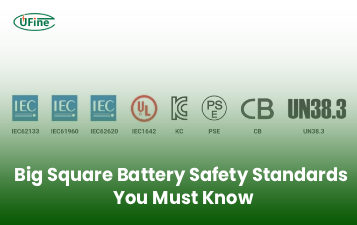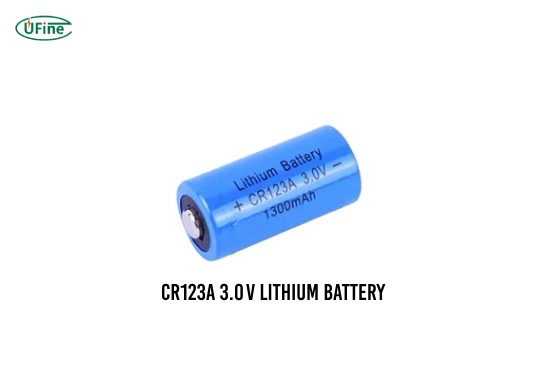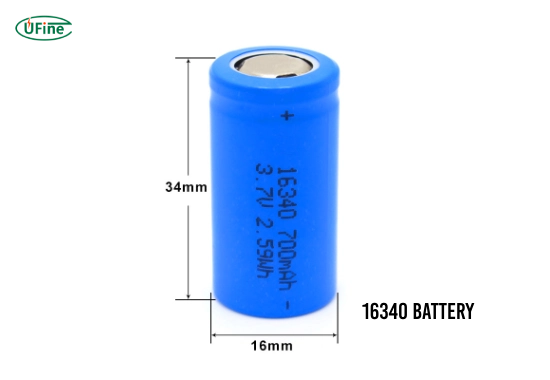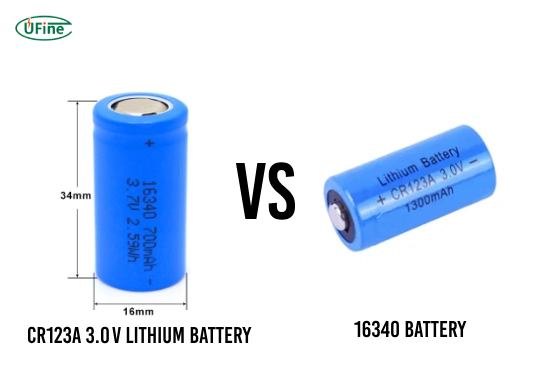
- Part 1. What is a CR123A 3.0 V lithium battery used for?
- Part 2. What is a 16340 lithium-ion battery and where is it used?
- Part 3. Can a 16340 battery replace a CR123A lithium battery?
- Part 4. CR123A vs 16340 battery voltage and performance comparison
- Part 5. Which battery type is safer: CR123A or 16340 lithium battery?
- Part 6. Lifespan and shelf life: How long do CR123A and 16340 batteries last?
- Part 7. What devices use a lithium battery CR123A 3.0 V?
- Part 8. What devices are compatible with 16340 lithium-ion batteries?
- Part 9. Cost comparison: Which battery is more economical long-term?
- Part 10. Charging guide: Can you charge CR123A lithium batteries?
- Part 11. FAQs about lithium battery CR123A 3.0 V
What is the difference between a lithium battery CR123A 3.0 V and a 16340 battery? The lithium battery CR123A 3.0 V and the 16340 battery are often mistaken for one another because they look very similar. However, they are quite different in terms of voltage, usage, rechargeability, and safety. If you use flashlights, security systems, or photography gear, choosing the wrong battery could damage your device or affect performance.
This article gives a clear and complete comparison of both battery types. We cover technical specifications, use cases, cost, safety, and compatibility. If you are unsure which battery to use, this guide will help you make the right choice.
Part 1. What is a CR123A 3.0 V lithium battery used for?
The CR123A 3.0 V lithium battery is a non-rechargeable primary battery designed for high-drain devices. It is popular in security equipment, medical instruments, photographic devices, and tactical flashlights.
Key features of CR123A lithium battery:
- Voltage: 3.0 volts
- Chemistry: Lithium manganese dioxide (LiMnO₂)
- Rechargeable: No
- Diameter: 17.0 mm
- Length: 34.5 mm
- Capacity: 1500 mAh (typical)
- Shelf life: Up to 10 years
- Operating temperature: -40°C to 85°C
The CR123A is valued for its long storage life, stable performance, and ability to handle high power bursts. It is a go-to battery for professionals who need reliable power in extreme environments.
Part 2. What is a 16340 lithium-ion battery and where is it used?
The 16340 battery is a rechargeable lithium-ion battery commonly used in flashlights, laser pointers, vape pens, and portable gadgets. It is similar in size to the CR123A but has different voltage and chemistry.
Key specifications of 16340 battery:
- Voltage: 3.6 to 3.7 volts
- Chemistry: Lithium-ion (Li-ion)
- Rechargeable: Yes
- Diameter: 16.0 mm
- Length: 34.0 mm
- Capacity: 700 to 1000 mAh (varies by brand)
- Cycle life: 300 to 500 full cycles
- Protection circuit: Often included in higher-quality models
Because it is rechargeable, the 16340 battery is economical and eco-friendly over time. However, it requires careful handling and proper chargers to ensure safety and efficiency.
Part 3. Can a 16340 battery replace a CR123A lithium battery?
In most cases, no. Even though the size is similar, the voltage difference makes them not directly interchangeable.
| Feature | CR123A Battery | 16340 Battery |
|---|---|---|
| Voltage | 3.0 V | 3.6–3.7 V |
| Rechargeable | No | Yes |
| Risk in voltage | Safe for 3.0 V devices | May damage 3.0 V devices |
| Size | 17 x 34.5 mm | 16 x 34.0 mm |
Using a 16340 battery in a device designed for CR123A could cause overheating, malfunction, or even permanent damage. Always check your device’s specifications before using a different battery model.
Part 4. CR123A vs 16340 battery voltage and performance comparison
Voltage is a key factor when comparing these two battery types. The CR123A supplies a constant 3.0 volts, which is ideal for sensitive electronics. The 16340, on the other hand, charges up to 4.2 volts, then drops to around 3.6–3.7 volts during use. This can cause issues in devices that are not designed to handle higher voltages.
Performance comparison table:
| Feature | CR123A | 16340 |
|---|---|---|
| Nominal Voltage | 3.0 V | 3.6–3.7 V |
| Max Voltage | 3.0 V | 4.2 V (fully charged) |
| Discharge Curve | Flat and stable | Steep drop-off |
| Capacity (typical) | 1500 mAh | 700–1000 mAh |
| Rechargeable | No | Yes |
In high-drain applications, the CR123A may last longer per use, but the 16340 can be charged many times, which may balance the overall performance over time.
Part 5. Which battery type is safer: CR123A or 16340 lithium battery?
CR123A batteries are generally safer for everyday users. They are sealed, non-rechargeable, and have a very low risk of leakage or explosion. In contrast, 16340 batteries require more attention. They must be charged correctly with the right charger. Overcharging or using a damaged cell can cause thermal runaway, leaks, or even fire.
Safety comparison:
| Safety Factor | CR123A Battery | 16340 Battery |
|---|---|---|
| Risk of Overcharging | None | High (if unprotected) |
| Built-in Protection Circuit | Not needed | Often included |
| User Handling | Very simple | Requires care |
| Temperature Stability | Excellent | Moderate |
If safety is your top priority and you do not want to worry about charging, go with the CR123A battery.
Part 6. Lifespan and shelf life: How long do CR123A and 16340 batteries last?
Shelf life refers to how long a battery can sit unused and still work well. CR123A batteries can last up to 10 years in storage without losing much power. On the other hand, 16340 batteries have a shelf life of about 2 to 3 years, even if not used.
Lifespan comparison chart:
| Feature | CR123A Battery | 16340 Battery |
|---|---|---|
| Shelf Life | Up to 10 years | 2–3 years |
| Recharge Cycles | Not rechargeable | 300–500 cycles |
| Best Before Usage | Emergency kits | Daily-use electronics |
If you need a battery for emergency equipment or long-term storage, CR123A is the better option. For frequent use and charging, 16340 may be more practical.
Part 7. What devices use a lithium battery CR123A 3.0 V?
The CR123A battery is widely used in professional and critical applications because of its high energy density and long life.
Common devices using CR123A:
- Security cameras
- Motion detectors
- Smoke alarms
- Tactical flashlights
- Night vision scopes
- Medical devices
- Emergency beacons
These devices benefit from the stable voltage output and long shelf life of CR123A batteries.
Part 8. What devices are compatible with 16340 lithium-ion batteries?
The 16340 rechargeable battery is used in consumer electronics, especially where frequent battery changes are expected.
Popular devices that use 16340:
- LED flashlights
- Headlamps
- Vape pens
- Laser pointers
- RC toys
- Portable speakers
- Compact cameras
These devices can handle a slightly higher voltage and benefit from rechargeable power sources.
Part 9. Cost comparison: Which battery is more economical long-term?
Let’s talk about money. CR123A batteries cost less per unit, but since they are not rechargeable, you will need to buy new ones repeatedly. In contrast, 16340 batteries cost more upfront, but they can be used hundreds of times.
Real-world cost comparison:
| Battery Type | Average Price (each) | Rechargeable | Estimated Total Use Cost (for 500 uses) |
|---|---|---|---|
| CR123A | $2.50 | No | $2.50 x 500 = $1250 |
| 16340 | $6.00 | Yes | $6.00 + charger ($15) = ~$21 |
If you plan to use batteries frequently, the 16340 is a cost-saving choice in the long run.
Part 10. Charging guide: Can you charge CR123A lithium batteries?
No, CR123A lithium batteries are not rechargeable. Attempting to charge them can cause leaks, overheating, or explosions. Use them only as directed and dispose of them properly after use.
If you need a rechargeable option, opt for the 16340 battery and ensure you use a compatible lithium-ion charger.
Part 11. FAQs about lithium battery CR123A 3.0 V
Can a 16340 battery be used in a CR123A flashlight?
Only if the flashlight supports the higher voltage of 3.6 to 3.7 volts, always check the manufacturer’s manual before using a 16340 battery.
Are CR123A batteries better for emergency use?
Yes. CR123A batteries have a longer shelf life, making them ideal for emergency kits and backup devices.
How many times can I recharge a 16340 battery?
A high-quality 16340 battery can be recharged 300 to 500 times, depending on usage and care.
What is the main risk of using a 16340 in place of a CR123A?
The higher voltage of 16340 batteries can damage devices that are only rated for 3.0 V. Always verify voltage compatibility.
Which battery is more eco-friendly?
The 16340 battery is more eco-friendly because it is reusable and reduces waste over time.
Related Tags:
More Articles

Big Square Battery Safety Standards You Must Know
Learn key safety standards for big square batteries to avoid fire risks, shipping delays, and compliance issues in EV, industrial, and energy storage projects.
Big Square Battery Applications in Solar & Industrial Equipment
Big square batteries deliver high capacity, stable output, and long life for solar, industrial, and backup power. Explore key uses and advantages.
Big Square Battery vs Cylindrical Battery: Complete 2025 Guide for EVs, ESS & Industrial Devices
Choosing the right battery is key for designers and engineers. Compare big square vs cylindrical batteries to find the best fit for your application.
How to Choose the Right Big Square Battery for Your Device?
If you’re choosing a big square battery for EVs, solar, or mobility devices, this guide helps you pick the right solution for real-world needs.
Big Square Battery Complete Guide: Types, Uses & Buying Tips
If you are choosing a big square lithium battery for EVs, solar, RVs, or AGVs, this guide helps you select the right NMC, LFP, or LTO solution with examples.





